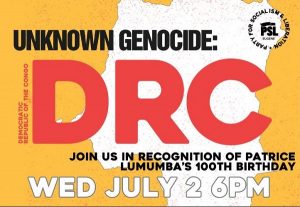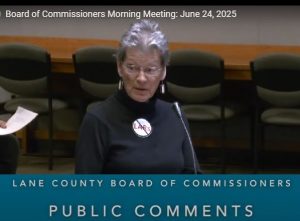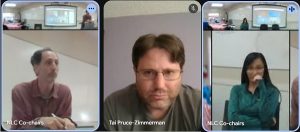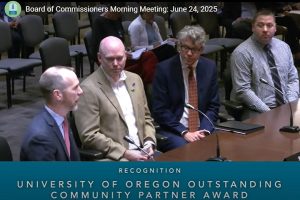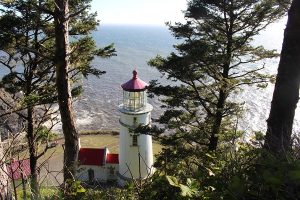State committee hears Lane County transportation needs
24 min read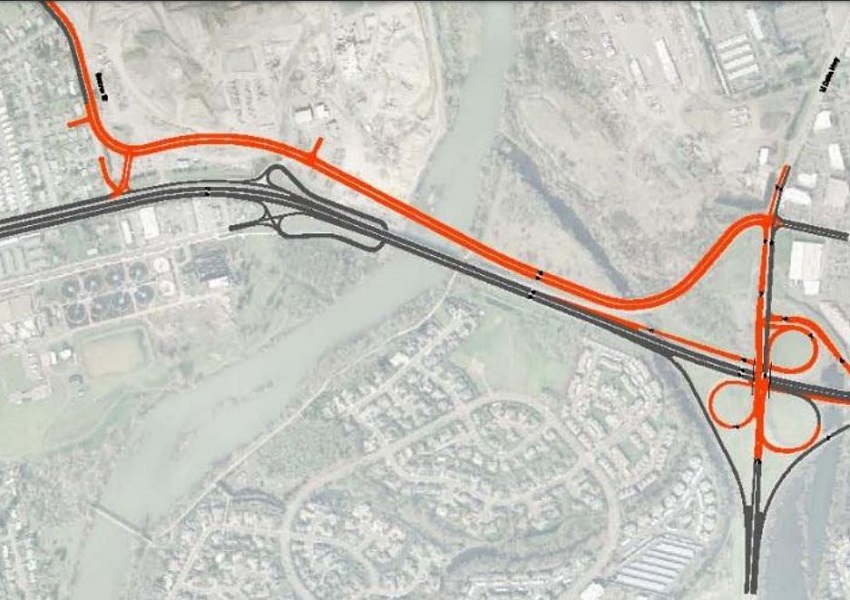
A local arterial bridge connecting Green Acres Road to the Beaver - Hunsaker area could reduce Beltline traffic by 25 percent.
The Joint Committee on Transportation convened in Eugene July 17 to hear Lane County’s needs, and how we might fund them.
Kevin Reed: My name is Kevin Reed. I’m here tonight in support of the development of the arterial bridge across the Willamette (River) at the Delta and Beltline and the Green Acres on-ramp there.
[00:00:18] I currently am representing six of the neighborhood associations that are impacted in that area of town representing about 90,000 of our residents: the River Road Community Organization, Santa Clara Community Organization, Northeast Neighbors Association, Cal Young Neighborhood Association, the Harlow Road Neighborhood Association.
[00:00:35] We’re also being supported by the mayors of both Junction City and the city of Coburg. We also have a tremendous amount of support from ODOT and from the city of Eugene on the development of this project.
[00:00:46] Our goal is to create a safety corridor because those of us that have lived out there for a number of years realize this is an absolute madhouse during the commuting hours and it’s very, very difficult to get emergency vehicles and emergency responders to and from any incidents that are happening on the east side of the river. That can’t continue on because there’s going to be a major catastrophe we’re all going to regret in the long run if we don’t do something about it.
[00:01:09] Also, the idea of being able to create a pedestrian and bike corridor along with a dedicated bus lane, along with automobiles that’ll be crossing at neighborhood speeds rather than Beltline highway speeds, will create a great opportunity for us to be able to connect the two areas of North Eugene and the Santa Clara neighborhood.
[00:01:26] I spent the last 15 years as the chair of the board of the Northeast Neighborhood Association and the top three issues that have come up—this has always been one of the top issues because the majority of the development has occurred in our area over the last five years. So something needs to be done and we’re hoping that we can get your support.
[00:01:44] The city of Eugene and ODOT have been absolutely wonderful and so has (Rep.) Nancy Nathanson for that matter and in supporting us and trying to get this done. We’ve been working on this for seven years and we’re hoping that we can get some energy behind this and see if we can’t create a solution to this situation. So it would also reduce the number of car traffic on Beltline by 17,000 cars a day.
[00:02:06] Richard Chasm: Hi, my name is Richard Chasm. I’m a candidate for (U.S.) House District 4, and this stretches from Camas Valley to Jacksonville. It’s bigger than Connecticut. And traveling around this district and talking to people, campaigning, one thing comes up over and over again (actually several things, but): The idea of passenger rail service to connect Southern Oregon to Eugene is something that people really are in favor of.
[00:02:32] I realize that there are funding issues and some track issues and things, but Southern Oregon feels separated from the rest of the state. The action is in the Willamette Valley and we don’t matter. I know that’s not true, but that’s the perception.
[00:02:48] Josephine County and Jackson County have a tourism-based economy. But also, we’re cut off from Eugene. You have no idea the impact, the positive influence that Eugene and Lane County has in Southern Oregon. It would not be livable without you. And a rail link would connect Southern Oregon to the rest of the state.
[00:03:14] It would connect Southern Oregon to the Amtrak system and the rest of the country.
[00:03:18] Shelly Clark: My name is Shelly Clark. I serve as councilor for the city of Creswell. I also serve as chair for our Lane Area Commission on Transportation. As I was thinking about the notes that I wanted to put together today, I just wanted to encourage you all to really heed the warning about the incredible need that we have for maintenance and safety across our whole state.
[00:03:38] And my encouragement to you all is to please work together, right, please work together to find ways to be able to think creatively and be able to meet the needs that we have.
[00:03:51] I work in a rural community, I serve a rural community and so I know that stories matter. We may not have the quantitative data to be able to back up the importance of what it is that we do, but we do have those stories.
[00:04:03] And so I want to give you a little bit of story about the Oakridge airport. The Oakridge airport is a state airport that has served a community that has been very hard hit by wildfire, especially over the course of the last couple of years. As we think about the last few years, the city has been on an evacuation notice or actually evacuated three times over the last three years.
[00:04:28] The airport has been closed for only wildfire evacuation for 220 days over the course of the last two years. Their landing needs to be rehabilitated dramatically. We will lose it in the next two years if it is not rehabilitated and complete.
[00:04:48] The Oakridge airport serves a critical safety need for Highway 58 if it is ever closed.
[00:04:53] Tim Hendrix: I’m Tim Hendrix. I’ve worked for nearly 49 years for a family-owned company founded in 1935 right here in Eugene: Wildish. I’m one of our managers and I’ve been on ATC’s Highway Council for 32 years.
[00:05:07] Wildish, as many of you know, has major sand and gravel, concrete and asphalt operations in this local community, right here in Lane County. Our 350 employees work not only in Lane County, but also all over Oregon. We build highways and bridges throughout all regions of the state. That’s our business. We provide lots of family wage jobs and together with our employees and their families, we pay lots of taxes. Wildish runs 250 vehicles all the way from dump trucks to pickups; our employees and their immediate families drive something like 800 to 900 rigs and extended families run another estimated 3,000 to 4,000 vehicles.
[00:05:50] We are all dependent upon roads and bridges to do our business and to get where we’re going safely and efficiently. My message is that good roads and bridges are a big part of the transportation links that Wildish and our people must have to run our business and to live our lives.
[00:06:08] Roads and bridges are much like all other investments. We want you as our representatives to recognize and act to sustain these investments by putting funds in place for the long haul to maintain these roads and bridges.
[00:06:23] Just like your homes, you, we must spend money to keep our roads and bridges in the best shape practical. We all owe it to each other and to our future generations to make sure we invest to sustain what we’ve already built.
[00:06:39] That takes money spent wisely so our roads and bridges are ready to support companies like ours and our employees and their families.
[00:06:47] Jason Armstrong: I’m Jason Armstrong with Wildish Construction based here in Eugene.
[00:06:51] We also do work throughout the state, as you heard earlier. Infrastructure funding and spending is vital to our state, local cities and agencies, as well as our approximately 350 employees. Dollars spent to improve and maintain our transportation system create family-wage jobs for all the laborers, operators, tradesmen that we employ and/or subcontract to.
[00:07:14] They provide spending of purchases for materials and fuel that also then go back into our transportation fund. Jobs outside of our construction industry, those wages providing dollars spent back into the communities and bring money back into the state. I appreciate your guys’ help in trying to work towards that infrastructure funding and thank you for the time.
[00:07:35] Sue Wolling: I’m Sue Wolling from here in Eugene. I have traveled by bicycle almost exclusively over the last 30 years, so I’m pretty comfortable at sharing the road with motorists. But in the past few years, that experience has changed pretty dramatically. I’m seeing aggressive driving, speeding, violation of traffic controls, and daredevil maneuvers unlike anything I’ve ever seen before. The roads are starting to feel unsafe, even to me.
[00:07:58] I can’t imagine how it is for the rest of the 25% to 30% of the population who doesn’t drive, either because they’re too old or too young or too poor or have medical conditions or don’t have a license or simply see no need to drive. This is not the time for ODOT to spend money it doesn’t have, building bigger roads that give motorists the message that driving fast and recklessly is what we expect of them and that their convenience is the highest priority for our limited transportation dollars. The roads we have invested in in the past need work to ensure that they still allow everyone to get where they’re going safely. This means the pavement is intact, shoulders are adequate and free of debris, speed is controlled, and safety measures are added where needed.
[00:08:41] For instance, how about adding a shoulder to Highway 99 between Eugene and Creswell and on to Cottage Grove, where people have died? Or replacing the bridge or else building a short off-street path along Highway 58 in Pleasant Hill so motorists and bicycles can avoid the high-speed jockeying for position at high speeds that terrifies everybody. These are the kind of affordable improvements that would make a difference in people’s lives and maybe even save those lives.
[00:09:10] Jim Neu: My name is Jim Neu. I’m a resident of Eugene, a volunteer member of 350 Eugene and Emerald Valley Electric Vehicle Association member and an avid bicyclist. I appreciate the opportunity to speak. I lived in the San Francisco Bay Area for more than 30 years where the remedy to traffic congestion was transportation infrastructure expansion.
That experiment created more lanes of traffic congestion, did not work, and led to the urban sprawl that paved over valuable farmland. The proposed expansion plan of more traffic lanes between Eugene and Veneta on Highway 126 will not alleviate traffic congestion in this area and would not pass an environmental impact study.
[00:09:48] I urge you to increase safety on this corridor by reducing speed limits in this area. The state of Oregon, Lane County and city of Eugene have climate action plans that set goals to reduce transportation greenhouse gas emissions.
[00:10:00] As a bicyclist I can attest to gross vehicle polluters. Small checks of vehicle registration every two years, much like Multnomah County and Medford, should be ubiquitous in the state.
[00:10:12] I urge you to implement smog checks in state-licensed vehicles every two years in order to reduce carbon emissions. Public transit, bicycle, and pedestrian means of transportation should be encouraged and made easy through infrastructure improvements.
[00:10:26] An example of this is in North Eugene where the belt line highway creates a transportation barrier between Santa Clara and North River Road neighborhoods. Many vehicle trips could be alleviated if pedestrian foot bridges were installed over the Beltline just west of River Road.
[00:10:42] City planning public surveys showed this improvement was high on the attendees’ and residents’ list. The state transportation system needs to invest in bike-pedestrian-public transit systems that make it fair and equitable for low- and fixed-income residents.
[00:10:57] Charlie Loeb: I’m Charlie Loeb from Eugene. I represent the Emerald Valley Electric Vehicle Association, which is an organization of electric vehicle advocates and enthusiasts in the Southern Willamette Valley and Central Coast.
[00:11:08] Our group educates and encourages people in our communities to make the switch to electric transportation. We strongly support the state’s goals for vehicle electrification, which will reduce air pollution and carbon emissions while benefiting both the state economy and people’s pocketbooks.
[00:11:23] As a group, we spend a lot of time talking to prospective EV owners, and I have two observations important for state transportation, policy, and finance. First, financial incentives are really important for people considering the purchase of an EV. With that in mind, please fix the Oregon Clean Vehicle Rebate, which is inadequately funded for meeting state goals, and this year was only available for vehicles purchased between April 3 and June 3.
[00:11:47] It’s very difficult to explain to EV purchasers the brief window to qualify for the rebate, and as a result, its effectiveness is seriously diminished. Funding a consistent rebate is essential even if it means a more narrowly focused program.
[00:12:01] Also, as you consider solutions for transportation funding in an era of dwindling gas tax revenues, please structure any new taxes and fees to incentivize the purchase of electric and other zero emission vehicles while disincentivizing more polluting choices.
[00:12:17] Some states have slapped punitive fees on the EV purchases and registrations, which clearly will discourage budget-conscious potential EV buyers and prevent them from switching to cleaner transportation.
[00:12:29] Let’s do better here and fund our roads with a system that makes it clear that vehicle owners will financially benefit from driving electric vehicles over the alternatives.
[00:12:37] Second, people often tell us they won’t switch to EVs because of particular concerns about charging. Some live in an apartment or other dwelling without their own garage or driveway where they can plug in, others travel frequently to rural areas of the state where they fear they can’t charge. You have programs to deal with this but it’s going to take a lot more investment in the near term.
[00:12:56] Allen Hancock: My name is Allen Hancock. I am from Eugene and I’m testifying about the proposed Highway 126 West expansion between Eugene and Veneta. The proposed widening from two lanes to four lanes with a turn lane and shoulders is a misguided approach to safety and for two reasons, one, environmental and two is financial.
[00:13:18] First, environmental: The road bisects wetlands. For those of you who have driven on both sides of the road, there are wetlands for much of the way. Expansion would require filling the wetlands, yet ODOT has declared a finding of ‘No Significant Impact’ on the environment. Can you believe that? On wetlands? That’s totally arbitrary. An environmental impact statement is needed, or at least an assessment. Not providing that does expose ODOT to litigation.
[00:13:47] Second, induced demand would increase traffic, which means more CO2. And ODOT has not accounted for this increased demand in their documentation. And we’ve seen across the country when roads are widened, more cars arrive.
[00:14:01] And third, widening would be inconsistent with the Climate-Friendly Communities legislation.
[00:14:08] Economic. ODOT has structural funding challenges. We know that. A proper environmental analysis and mitigation would be very costly. And just widening a road from two lanes to four lanes when you’ve got fill and wetlands would be tremendously expensive.
[00:14:25] What we do need to address the real safety problem in this corridor is we need low-cost solutions such as roundabouts at key intersections.
[00:14:34] We need funding for regular transit service between Veneta and Eugene, which has been reduced. And we need a safe and pleasant route for bicycling south of Highway 126 away from the noise and pollution and traffic.
[00:14:48] Pete Knox: My name is Pete Knox. I’m on the Lane Transit District Board of Directors. I represent downtown and surrounding neighborhoods. I’d like to welcome you to my subdistrict.
[00:15:01] That being said, I’d like to talk about STIF. State Transportation Improvement Funds provide the projects that are not necessarily on budget for LTD or LCOG (which is our metropolitan planning organization), which we work with to come up with the list of projects that STIF is funding.
[00:15:22] Committee members, I ask of you to remember how important these funds are and to not only continue to support those funds, but find a way to expand them.
[00:15:36] Kelly Clarke: My name is Kelly Clarke. I’m the principal transportation planner for the Lane Council of Governments, and I’m also a resident of southern Eugene. I am here representing Link Lane, which is the Lane Council of Governments’ rural transit service.
[00:15:48] Link Lane connects rural and coastal areas of Lane County with the urban Eugene Springfield area. Link Lane also connects our transit providers within and beyond Lane County, making car-free travel options possible for the general public. Our services include two intercommunity routes that contribute to the statewide transit network. One is between Florence and Eugene and the other one is between Florence and Yachats.
[00:16:11] And we also have one on-demand service in southern Lane County. Our riders utilize Link Lane for a wide range of purposes from medical and treatment needs to recreation to social connections and many others.
[00:16:24] Many of our riders are dependent upon our services to travel between the coast and the metro area or throughout southern Lane County.
[00:16:32] We have seen an increase in ridership since we began our service in 2019 and have actually needed to apply for grant funding from various sources to secure money to purchase buses with greater seating capacity to accommodate our ridership numbers.
[00:16:45] To make this service a reality, we are partners with and coordinate frequently with Lane Transit District, the Oregon Department of Transportation, and the Confederated Tribes of Coos, Lower Umpqua, and Siuslaw Indians. Our success is dependent upon these partnerships as we all work to create and expand upon a reliable and dependable public transportation network with sustainable funding.
[00:17:05] We encourage you to continue to support public transportation funding, and especially funding that supports ongoing maintenance of these vital lifeline routes.
[00:17:12] Ruth Linoz: My name is Ruth Linoz. I’m the executive director of South Lane Wheels, I’m based in Cottage Grove. Since 1982, South Lane Wheels has provided safe, reliable and accessible transportation that has empowered people living in rural areas to connect with their communities and critical resources.
[00:17:33] Most of our residents live below the poverty level and prefer to raise their families and age in place. South Lane Wheels has operated origin-to-destination (or commonly called door-to-door service), a deviated bus route, non-emergency medical transportation services, and a bus route between Roseburg and Eugene transit hubs with stops in three rural communities.
[00:18:02] The service that has added the most value in our region was funded by Statewide Transportation Improvement Funds. Starting in 2019, Lane Transit District used STIF funds to operate the first rural on-demand app-based service within the city limits of Cottage Grove called the LTD Connector.
[00:18:25] I’m proud to report that the funds have enabled all residents to experience same-day, highly flexible, low-cost service to get to their jobs, to recreate and to purchase goods and services with their local business community. To me, this is a great example of a STIF program giving back to a rural community and it enhances the mix of transportation options in South Lane.
[00:18:55] Chieko Tomasulo: My name is Chieko Tomasulo, I’m a resident in Cottage Grove and I am I guess representing the group of people that take the transportation service provided by the MOD (Mobility on Demand) program.
[00:19:08] I experienced the South Lane Wheels prior to and since the MOD (Mobility On Demand) came in place and it allowed me to have a couple of different jobs within town that I would have found it more difficult to get to without the local transportation also in those two jobs (which happened to be the local food bank community sharing and senior and disabled services) interacted with a large number of the population in town that still asked me questions even in the grocery store and that helped them to get to the grocery store, to get to the medical appointments, to meet with their friends, to go to some of the events that occur during the weekdays and it’s very low cost, very quick to call them or use the app to do it automatically through your mobile phone for those that can use that app and it’s been a very worthwhile service that would find it difficult to maneuver around town without it.
And I appreciate the fact that the state has allocated funds for us and I hope we continue to get that. It’s something that a lot of people in town would not be able to access a lot of those services and meet with their friends and get to places that they would need to. So we really appreciate that and we hope we can continue to receive funds for that program.
[00:20:30] Todd Keiser: Hi, my name is Todd Keiser and I’m here for the Pearl Buck Center. We service the intellectually development disabled and our clients are very reliant on LTD and the RideSource system. So, I would be here saying to please fund that as much as possible.
[00:20:50] The current system, the feedback that I received coming here, is overall it’s a good system. They’ve got a lot of good patient drivers that really care about what they do.
[00:21:01] But there’s flaws in the system. One of our programs is we help people get jobs and keep them. If a RideSource can’t get them to their job on time, they’re not going to have a job for very long. We were told by RideSource that they have a 30-minute window as to whether the start and end time of when they would deliver. That doesn’t really work when you’re getting off work and your place of business is closed, now you’re waiting for 30 minutes in the dark in the rain.
And these are clients and individuals that when they’re employed and they’re happy, they make a huge difference to their community, their employers are happy, their coworkers are happy, their families are happy, it makes a huge difference in the community when we can place these individuals with jobs and they can rely on them.
[00:21:51] So I think the biggest message I have is that as much as it makes a difference to our clients as well, you could say that if you can help them, you can also help other people, ’cause we’re going to be more reliant on buses with those new parking rules and structures. People aren’t going to have parking spaces, so we’re going to need more public transit.
[00:22:13] David Diaz: My name is David Diaz and I have been a resident for Lane County for now 26 years. Just like to thank you guys again for being here today. I stand before you to advocate for a crucial cause that affects many members of our community: Improving public transportation access and ride sources services for individuals with intellectual and development disabilities, particularly to the Pearl Buck Center located on West First in Eugene.
[00:22:36] The Pearl Buck Center is a vital resource for individuals with disabilities, providing education, employment opportunities, and support services. However, many of these individuals face significant challenges in accessing these essential services due to inadequate transportation options.
[00:22:51] This lack of reliable transportation can severely limit their opportunities for personal growth, social interaction, and independence. One of the primary issues we face is the need for better public transportation access to Pearl Buck Center.
[00:23:04] It’s essential that we work towards enhancing bus routes and schedules to ensure that individuals with disabilities can easily, reliably reach this important facility. This includes not only increasing the frequency of buses, but also ensuring that stops are conveniently located and accessible.
Additionally, we must address the shortcomings of RideSource transportation services. Far too often, individuals experience delays or miss their appointments because transportation services are not punctual. Arriving on time and being picked up on time are not luxuries, they are necessities. These services must be reliable and efficient to ensure that individuals with disabilities can fully participate in the programs and opportunities offered here in Lane County.
[00:23:41] Improving transportation access is not just about convenience, it’s about equality and inclusion. Every member of our community deserves the opportunity to live a full and independent life and transportation should never be a barrier to achieving that.
[00:23:55] I urge our local government, transportation authorities, and our community leaders to prioritize these improvements. Together we can make a tangible difference in the lives of the individuals with disabilities ensuring they have support and resources they need to thrive.
[00:24:09] Thank you guys for your attention and your guys’ support in the matter.
[00:24:13] Mike Sauerwein: My name is Mike Sauerwein. I currently serve as city manager for the city of Cottage Grove… I’m old, which has made me keenly aware of why it is essential that Oregon build and maintain a multimodal transportation system throughout the state. I think it’s really important to note that the state transportation system directly impacts us at the local level. Cottage Grove, for example, is bisected by both I-5 and Highway 99. Back in 2023, the Cottage Grove City Council formed an ad hoc street improvement committee to review our current street system, secure public input, and make recommendations to our city council.
[00:24:50] The committee identified $35 million in deferred maintenance on our city streets; we’re only a city of 11,000 people. Much of it is related to connections with the state highways. One option to address this maintenance backlog would be the formation of Transportation Improvement Districts funded by vehicle registration fees or car tag renewals. It’s my understanding that this would require legislative action and we encourage you to consider this opportunity for local funding.
[00:25:17] Finally, I strongly encourage funding transit projects which are the connection between our cities, keeping safety as a top priority with improved pedestrian crossings and safe transportation to and from schools, and perhaps most importantly, starting the transition from gas taxes to road user fees to stabilize our transportation revenue.
[00:25:37] Albert LePage: Albert LePage, Eugene. Three key points for fair and sustainable funding: Solutions, equity, and priorities.
Solutions: Road user charges. Implement a statewide program similar to OReGO, which I myself voluntarily belong to, based on miles driven. Delivery and ride share fees. Introduce fees on these services and companies to address increased wear and tear on roads. Vehicle weight-based fees, given the greater impact heavier loads have on road infrastructure.
[00:26:11] Number two, equity, such as myself, support low- and fixed-income residents, new funding mechanisms such as progressive taxation, lower per-mile rates and exemptions. Invest in public transit and active transportation, expanding such as biking and walking paths that can provide affordable and sustainable alternatives to driving.
[00:26:39] Off-street paths are essential for active transportation networks, providing safe, accessible routes for walking and biking, which I myself use in Eugene for access to nature and health. Therefore, Oregon needs policy language that includes bike/ped facilities and major capital projects, ones that align with federal policies so they’re more competitive and can leverage better funding opportunities. Also increase investment in programs like Oregon Community Paths.
For priorities, I would look at maintenance and safety, addressing the maintenance backload, it’s critical for safety and reliability, and also investing in Safe Routes to School, Community Main Streets, and multi-use paths. And finally, climate goals.
[00:27:22] Resha Oylear: My name is Resha Oylear and I am the program director with MTM Transit, providing services with RideSource in the Eugene Springfield area. I just want to say that the services that we provide, our mission statement as Lane Transit District is, ‘to bring together communities.’
[00:27:41] So at RideSource, our ultimate goal is to provide services to those that are in need of transportation to get from point A to point B. We do the paratransit services and without those services there are many residents in the Lane County area that who have stated to us would not be able to leave their homes.
[00:28:07] We served over 5,000 trips per month on our paratransit service and every one of them is equally important.
[00:28:16] Annie Herz: My name is Annie Herz and I’m the executive director of Sponsors, Inc., which is a reentry program that has been a vital resource in Lane County for over 51 years. Sponsors, as some of you may know, is a national leader in the delivery of reentry services for people returning to the community after incarceration.
For the last decade, Sponsors have been receiving subsidized bus passes for all of our participants. So with the 75% subsidy, we end up paying $42,000 a year and saving $119,000 a year. Transportation is a critical component of successful reentry into the community. The ability to utilize services of LTD allows Sponsors participants to seek employment, to get to and from work once they’re employed, to travel to medical or mental health appointments, to see family members, and to have the experience of being an integrated member of the community.
[00:29:17] Hunter Nelms: My name is Hunter Nelms. I am formerly incarcerated, a person in long-term recovery from substances, and I’m the peer supervisor at the Restore Connections Peer Center where we serve hundreds of individuals struggling with substance use, unemployment, transportation issues, etc. We are a small startup, but we have made a large impact on our community with the slim funding that we have, being entirely Measure 110-funded.
[00:29:39] If not for the nonprofit program and discount offered by LTD we would be virtually handcuffed to offer bus passes and day passes to people so they can get to job interviews and their shifts once jobs are secured, get to vital substance use disorder treatment and individual therapy appointments, and also to make it on time to visit with their children when involved with the system.
[00:29:59] Chrissy Barnard: My name is Chrissy Barnard. I’m a CRM-II and the first housing specialist at Restore Connections Peer Center, a peer-run organization. It is our goal to offer peer support to anyone who identifies with having a substance use disorder.
[00:30:14] Transportation being one challenge that can affect so many of these areas. Our individuals are up against various systems which requires them to make multiple appointments sometimes all in one day. That could include treatment, meeting with their probation officer, court appearances, visits with their children, making it to interviews to secure things like housing and employment. Both RideSource and the bus systems are instrumental in making it possible for someone to show up in their own lives and navigate these types of responsibilities.
[00:30:45] It is often gaining that momentum by making it to just one appointment and feeling empowered by the tiniest gust of wind under your wings that makes it possible for us to fly. There is a saying in recovery: ‘One step at a time.’ And having a bus pass in your pocket makes it possible to make many of those steps.
[00:31:02] Crystal Pearsall: My name is Crystal Pearsall, I’m a CRM-II and a team leader at Restored Connections Peer Center. RCPC serves individuals with many different barriers to getting their life back on track from substance use disorder, homelessness, and mental health barriers.
[00:31:16] Being able to provide the community we work with with transportation bridges the gap. This may be a small thing to some, but to others it can be it can make all the difference.
[00:31:26] Marc Mason: My name is Marc Mason. I’m the program coordinator of the crisis team at White Bird Clinic. White Bird’s mission is to serve the needs of the most vulnerable members of our community. We’re guided by the principles of compassion, client-centered care, individual empowerment, and service accessibility.
I’m here today to represent members of the community that benefit from the cab rides through behavioral health transport and assessment services. LTD serves community needs by offering a cab ride program that allows clients to access transportation for medical and social service appointments and to assist with basic needs.
[00:32:04] John Hickey: My name is John Hickey. I’m with the Asphalt Pavement Association of Oregon. And I want to comment on the magnitude of the problem. Because I’ve listened to all of these listening sessions and I do feel like not many people truly understand the magnitude of a problem. We have a pavement system in the state. How pavements work is they just degrade somewhat slowly at first, then there’s an inflection point and they degrade really quickly.
[00:32:36] When you’re on the bad side of that inflection point, pavements cost a lot more to fix. So we are flying. Our pavement system, we’ve done a good job of maintaining pavements at the top end of that curve. Well, they’re heading to that inflection point.
[00:32:52] And what can we do to stop them from getting to the bad side of the curve? Really with the current funding situation in the state of Oregon, there’s no chance. Right? There’s no chance to stop it.
[00:33:05] And so thinking about what that requires, like, more than doubling what we all pay to use the infrastructure system: super heavy, heavy lift politically…
[00:33:17] Here’s the good news. I found that very few people actually know how little they pay to use the roads, right? So I ask people all the time, especially with what I do: ‘How much do you think you pay?’ Most people answer that question and they say, ‘Well, out of my taxes, I think about $1,000, $2,000 a year probably goes to the roads.’
[00:33:39] And I’m like, no, ‘Well, it’s actually like $300 – $400 at the most if you drive a lot,’ right, and they don’t believe me, so I have to do the math and convince them, but that’s the message. Big need, people don’t get it, the bright side is, if they paid what they think they pay, we’d probably be okay.
[00:34:00] John Q: The Joint Committee on Transportation visits Lane County and hears about needs for: the North Eugene arterial bridge; passenger rail; the Oakridge airport; pedestrian foot bridges; safe routes for bicyclists; and continued support for vital transit services.
Some funding ideas: fees based on vehicle weight; and Transportation Improvement Districts, funded by vehicle registration and car tag renewals.
The committee was also asked to protect the wetlands west of Eugene.
This subset of public comment participants was selected by dividing the full meeting into three parts, selecting one of the three parts, and rearranging the sequence of speakers. Written testimony and video of all speakers is available through the Oregon Legislature website.
